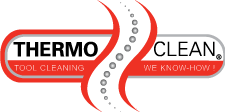Removing plastic from technical parts
At the instruction of companies that manufacture or process plastics, we remove plastics from technical parts. These parts get contaminated during the processing of plastics, which means they need to be cleaned at regular intervals. To do so, we use the thermal cleaning technique.
In practical terms, we remove caked plastics from extruder screws, filters, moulds, pipelines, dies, heat exchangers,… Each of these are highly costly production machinery parts and components that require a specific cleaning approach.
Alongside plastics, we also remove associated contaminations such as caked oils or fats. Many of our customers operate in the plastic, chemical or petrochemical industries.
How does thermal cleaning work?
To remove plastics we mainly use thermal cleaning, with the exception of a few specific types of filters for which we use a pyrolysis oven. At a temperature of 400 °C – and a very low oxygen content (8%) – we convert the organic materials into smaller molecules.
This breaking down of the macromolecules results in:
- Pyrolysis gases (ethane, ethene, propane and propene)
- Pyrolysis oil with aromatic components
- High carbon residue
We then convert the pyrolysis gas and the pyrolysis oil into carbon dioxide and water vapour by way of partial oxidation. Up to 40% of the energy released during this processing step is reused to break down the organic material.
Preventing damage
To prevent damage to the parts set to be cleaned, it is paramount that the temperature is made to rise evenly and is subsequently kept constant. Even cooling is just as important. This is why we are required to use extremely finely tuned oxygen-controlled ovens.
Thermo-Clean runs state-of-the-art installations that can be controlled with the utmost precision. In doing so, our ovens run the cleaning programme at object temperature instead of room temperature.
We are able to set the pyrolysis oven in such a way that the temperature will rise or drop by no more than 40 °C an hour or 1 degree per minute for instance. This acts to prevent differences in temperature between the thin-walled and the thick-walled parts of large heat exchangers for example, which also rules out the risk of deformation due to local overheating. We can provide you with graphs of the different object and oven temperatures for every cleaned part, so you can perfectly archive-store these part-specific data.
Which parts get the thermal cleaning treatment?
Our extensive installations are eminently suited for cleaning heat exchangers, removing resin coats on large electric motors, cleaning blow moulding dies and extruder screws up to no less than ten metres.
